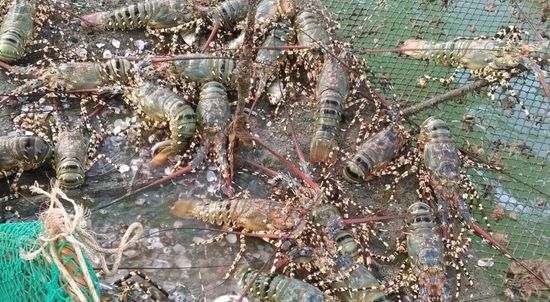How To Operate A Lobster Farm For Export

Commercial lobster farming is becoming very popular day by day and it’s a very profitable business. Among all the highly-priced marine crustacean, lobsters are larger in size. A mature lobster weights between 250 to 400 grams. Lobster farming with carp or other fish species is very profitable and easy. If you wish to start lobster farming business, then you can cultivate only lobsters in a pond or with other fish species like Rui, Katla, Mrigal etc. Here I am describing the steps for staring lobster farming business.
POND SELECTION
The pond management for lobster farming should done well. The pond, where the lobster will be cultivated needs more oxygen than usual. Selected pond must have to suitable enough for changing frequently. So, it will be better if you select the pond near a river or canal. Doing this will ensure constant water supply. If any source of natural water like river or canal is not available, then you have to setup a tube well for continuous water supply. Sandy soil is better for lobster farming. Ensure sufficient availability of the sun light. It would be better if there are no big trees near the shore of pond. The area or size of the pond may be any depending on your production type. But it would be better, if the pond is constructed over at least one acre of land. The depth of the pond must be between 1 to 1.5 miter.
Preparing the Pond
At first, remove water from the pond and make it dry. You will be able to remove all types of carnival and unwanted fish species from the pond by making it dry. Drying also remove harmful gas and virus from the pond. Apply 3 grams of rotenon (harmful aquatic insects and fish killer) per each cubic meter, if it is not possible to dry the pond. Applying rotenon or something else related to this will fully remove all types harmful fish species from pond. After that apply 100 kg of lime per acre. After 5 to 7 days of applying lime in the pond, apply 500 kg
cow-dung, 10 kg nitrogen, 5 kg TSP and 2 kg of MAP per acres. Keeping favorable environment in the pond is very essential for successful lobster farming business.
cow-dung, 10 kg nitrogen, 5 kg TSP and 2 kg of MAP per acres. Keeping favorable environment in the pond is very essential for successful lobster farming business.
SELECTING LOBSTER SPECIES
There are numerous lobster species available. Among those species farming adik-adik, bamboo and tiger lobsters are very profitable. Because these species grow faster and have huge demand and price in the local and international market. This three species are different from each other like their name. The adik-adik lobsters are of reddish black in color. Bamboo lobsters have striped legs and it’s seems like bamboos. On the other hand tiger lobsters have spotted legs. You can choose any of these breeds depending on your location and desired production type.
STOCKING LARVAE
Stock the larvae after 5 to 7 days of applying fertilizer in the pond (when the water become green colored). The number of the larvae depends on the size of your pond. The number of larvae also depends on the fertility of soil, availability of supplementary feed and proper management. In general management 10,000 pieces of larvae can be stocked per acre. If you can ensure constant water supply and supplementary feed management, then you can stock more larvae. Lobster larvae don’t grow well in a high stocking density. They may fight with each other if they face supplementary feed lacking. Be more careful during caring the larvae from the hatchery. Good and high quality lobster larvae increase the possibilities of more profit from lobster farming business. So always try to purchase the larvae form good and reputable hatcheries.
SUPPLEMENTARY FEED
You can notice the production of harmful gas in the pond, after applying fertilizers. So remove the gas first to get proper growth of lobster larvae. You can ensure enough natural food for your lobster larvae by applying fertilizer in the pond. But this natural feed is not sufficient. So you have to provide supplementary feed in the pond. Actually proper growth and profit in lobster farming business depends on providing adequate and quality supplementary feed. Notice the chert below to have an idea about the ingredients of 1 kg supplementary lobster feed.
Wheat Chaff 600 g
Mustard cake 150 g
Kipper powder 250 g
Snail powder 95 g
Salt 3 g
Vitamins 2 g
Totals 1000 g/1 kg
APPLYING METHOD
Provide 4 percent of supplementary feed daily according to the body weights of the lobsters. Feed them twice a day. Once in the morning and rest in the evening. Amount of providing supplementary feed per 1000 lobster according to their age are listed on the following chart.
Age Amount
First month 15 g
Second month 75 g
Third month 150 g
Fourth month 400 g
Fifth month 1 kg
Six month 2 kg
Seventh month 2.5 kg to 3.0 kg
FERTILIZER
Using fertilizer in the pond is very necessary for lobster farming business. Applying fertilizer in the pond helps to increase the natural food production for the lobsters. Lobsters change their shell at different stages of their life. They become very sick when they change their shell. So you have to take extra care during this time. You can keep some tree branches or bamboo in the pond during this time. It will provide them shelter and help to prevent mutual attack.
COLLECTING LOBSTERS
Generally lobster reach marketing weight, when they reach 6 to 7 months of age. You can start collecting lobsters, when they reach more than 100 grams weight. You can collect lobsters from the pond by using various types of net. Keep the lobsters in dry place or store using ice. If you follow all the steps described above, then you will be able to produce 800 to 1000 kg lobsters from a pond of 1 acre. And it will definitely ensure maximum profit from your lobster farming business.







